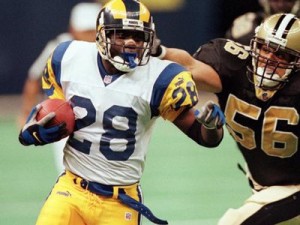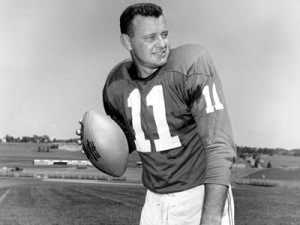On Monday, I looked at the Defensive Player of the Year voting in every year from 2000 to 2006. Today, the last eight years.
2007: Bob Sanders, Indianapolis Colts
AP voting: Sanders (31), Patrick Kerney (4) (Seattle), Albert Haynesworth (4) (Titans), Antonio Cromartie (3) (Chargers), DeMarcus Ware (3) (Cowboys), Mike Vrabel (2) (Patriots), James Harrison (1) (Steelers), Ronde Barber (1) (Buccaneers), Patrick Willis (1) (49ers), Mario Williams (1) (Texans)
Sanders picked up 62% of the vote, yet nine other names split the remaining ballots. It is weird to think of a player like Kerney as being the runner up for DPOY. But in his first year in Seattle, Kerney had 14.5 sacks, forced five fumbles, and recorded an interception, good enough to get him the KC101 NFC Defensive Player of the Year award.
But Sanders was the clear choice for DPOY. Only a couple of random places (like the Kansas City Star, which went for Ware, the New York Daily News (Cromartie), or the Miami Herald, which went for Vrabel because LBWINZ) didn’t select Sanders as the top defender that season.
Verdict: A worthy DPOY season for Sanders. And the first of back-to-back DPOY-caliber seasons that would land Haynesworth a $100M contract.
2008: James Harrison, Pittsburgh Steelers
AP voting: Harrison (22), DeMarcus Ware (13) (Cowboys), Ed Reed (8) (Ravens), Albert Haynesworth (5) (Titans), Troy Polamalu (2) (Steelers)
This was another close vote: Harrison didn’t quite get half of the AP voting, but did win by a healthy margin. This was far from a unanimous seletion: Peter King at Sports Illustrated, John Clayton at ESPN, and Mark Gaughan at the Buffalo News all chose Ware, Rick Gosselin at the Dallas Morning News and Leonard Shapiro at the Miami Herald selected Reed, while the Sporting News poll of players, coaches, and general managers landed on Haynesworth. The KC101 awards went to Harrison and Ware as the top defenders in each conference.
The Steelers defense was outstanding in 2008. It finishes two standard deviations above average in points allowed, and ranked as the 10th best pass defense ever. And Pittsburgh ranked 1st or 2nd in yards per carry allowed, rushing yards allowed, and rushing touchdowns allowed. Harrison, of course, cemented his play in ’08 with one of the greatest plays in NFL history, a 100-yard interception return for a touchdown in Super Bowl XLIII.
Verdict: Harrison’s 16 sacks finished 4th in the NFL, and he was second on the team in tackles. A very deserving choice for the award. As for Ware, this was the closest he ever got to winning the DPOY award. In fact, he received just 3 other votes over the remainder of his career from AP writers, all in 2007 (although he did have a DPOY-caliber year in ’11, too).
2009: Charles Woodson, Green Bay Packers
AP voting: Woodson (28), Darrelle Revis (14) (Jets), Darren Sharper (3) (Saints), Elvis Dumervil (3) (Broncos), Jared Allen (2) (Vikings)
One of the more interesting DPOY races, as the top two players played the same position — but in very different ways. Revis was a dominant shutdown corner, having one of the greatest individual coverage seasons in recent history. Woodson was a great coverage corner who also played in the slot, or at safety, and was a pretty effective blitzer, too. The AP voters preferred Woodson’s all-around game at a 2:1 ratio, but there were dissenters.
Sports Illustrated’s Peter King selected Revis, as did the New York Daily News. USA Today had Revis winning by the narrowest of margins over Woodson and Dumervil. But Woodson did take home the majority of the hardware, including from Pro Football Weekly / Pro Football Writers of America and the Sporting News and the majority of sources out there. There were a couple of straggler votes — Tony Grossi of the Cleveland Plain Dealer chose Dumervil, Leonard Shapiro of the Miami Herald selected Sharper — but this was largely a two-man race.
Verdict: The ’09 Jets led the league in net yards per attempt allowed, points allowed, yards allowed, first downs allowed, passing yards allowed, and passing touchdowns allowed. Revis was the main reason for the defense’s success, and I’m not sure he had a finer year. Both he and Woodson appear to be future Hall of Famers. Of note: Woodson was named the Defensive Back of the Year by the NFL Alumni voting, and each player took home the Defensive Player of the Conference award from he KC101 organization.
2010: Troy Polamalu, Pittsburgh Steelers
AP voting: Polamalu (17), Clay Matthews (15) (Packers), James Harrison (8) (Steelers), Julius Peppers (6) (Bears), Brian Urlacher (2) (Bears), Haloti Ngata (1) (Ravens), Ed Reed (1) (Ravens)
The Steelers safety received just 34% of the vote, narrowly edging Matthews for the AP honor. Was Polamalu the best defender in 2010? Well, in the Sporting News poll, Matthews took home the award with the voting going 188-148; the Packers outside linebacker was also the Pro Football Weekly/Pro Football Writers choice. As you would suspect, Peter King was again an outlier, going with Peppers as his top choice. Polamalu received the AP nod by a tiny margin, but
Verdict: Matthews deserves at least as much credit as Polamalu for what he did in 2010. The fact that the AP Trophy is considered “official” is kind of silly, but that goes double when the voting was this close. The Packers outside linebacker may be building a Hall of Fame career, and it would be ridiculous to think that two out of 50 votes from certain AP writers in one season would make a difference in that outcome. Then again, while Polamalu seems like a HOF lock, if he came in second place in ’10, would his case be any different?
2011: Terrell Suggs, Baltimore Ravens
AP voting: Suggs (21), Jared Allen (14) (Vikings), Justin Smith (6) (49ers), Jason Pierre-Paul (5) (Giants), Patrick Willis (2) (49ers), NaVorro Bowman (1) (49ers), Charles Woodson (1) (Packers)
Suggs was also the Pro Football Weekly / Pro Football Writers of America DPOY and the choice of a panel of 8 writers at Sports Illustrated. The Sporting News chose Allen as its top player, with DeMarcus Ware as the runner up there. The KC 101 chose Suggs and Allen as the top player of each conference. This wasn’t unanimous, and it wasn’t a runaway win, either, but Suggs was a legitimate winner. The Ravens defense ranked in the top 3 in points, yards, net yards per pass attempt, yards per carry, and rushing yards, while Suggs had 14 sacks.
Verdict: Allen had 22 sacks, making it the second most impressive sack season since ’82. Suggs was a worthy choice, but Allen — who is a borderline HOF candidate — deserves a ton of credit for his monster season while playing for a 3-13 team.
2012: J.J. Watt, Houston Texans
AP voting: Watt (49), Von Miller (1) (Broncos)
This was one of the most dominant defensive seasons in NFL history, and that is reflected in the voting. Consider this: over the course of their careers, Reed (29) and Polamalu (22) combined for 51 DPOY votes from the AP. Meanwhile, Watt had 49 just this year. Aldon Smith was named the KC 101 NFC DPOY and the runner up according to The Sporting News, but Watt was basically a unanimous choice here.
Verdict: J.J. Watt is the man.
2013: Luke Kuechly, Carolina Panthers
AP voting: Kuechly (13), Robert Mathis (11.5) (Colts), Earl Thomas (7.5) (Seahawks), Robert Quinn (6) (Rams), Richard Sherman (4) (Seahawks), J.J. Watt (2) (Texans)
Sandwiched in between Watt’s two scorched-earth campaigns was one of the closest DPOY races in NFL history. Mathis actually received more All-Pro votes than Kuechly, although the Colts star wasn’t the only one with a good case for the award.
The Pro Football Writers of America and Sports Illustrated chose Quinn, although the Sporting News also went with Kuechly. Pro Football Focus chose Watt, while the KC101 went with Kuechly in the NFC and Mathis in the AFC. Oh, and the Seahawks had a historically dominant pass defense and two very deserving candidates, too.
Verdict: There were a number of great candidates during the ’13 season. Kuechly may be building a HOF career: he was the Defensive Rookie of the Year in 2012, the DPOY in 2013, and has been a first-team All-Pro by the AP in 2014. Last year may have been his best season, and he was Pro Football Focus’ top inside linebacker. But I’ll still always remember him as this guy.
2014: J.J. Watt, Houston Texans
A unanimous winner, the first of its kind since the AP began giving out this award. Watt also received 13 votes in the MVP voting, so it was that sort of season. Everyone chose Watt as the league’s best player, although it’s worth noting that Richard Sherman did get chosen by the KC101 as the top defender in the NFC.
Verdict: J.J. Watt is the man.




